India’s Opportunity Explained in Charts
Successful thematic investing is not just about correctly identifying long term structural trends but also positioning yourself early to take advantage of them as they unfold. We have identified several positive structural changes occurring in India that make it a very attractive opportunity for thematic investors. This long-term opportunity drives the logic behind the set-up of our business, India Avenue. We look at several charts below that illustrate India’s future economic potential.
Population Demographics
A demographic dividend occurs when the proportion of working people in the total population is significant. Countries going through this phenomenon are likely to experience accelerated economic growth driven by the most productive part of the population. Looking at the population pyramids below, the distribution of India is heavily skewed towards youth and working age, unlike many other countries around the world that grapple with aging.
The following demographic statistics are impossible to ignore:
- 46% (around 600m) of 1.3 billion people are below the age of 25
- 64% (around 830m) of the population are working age i.e. 15-64
- There are more 9-year old’s in India than the population of Australia
- 1 million people turn 18 every month in India
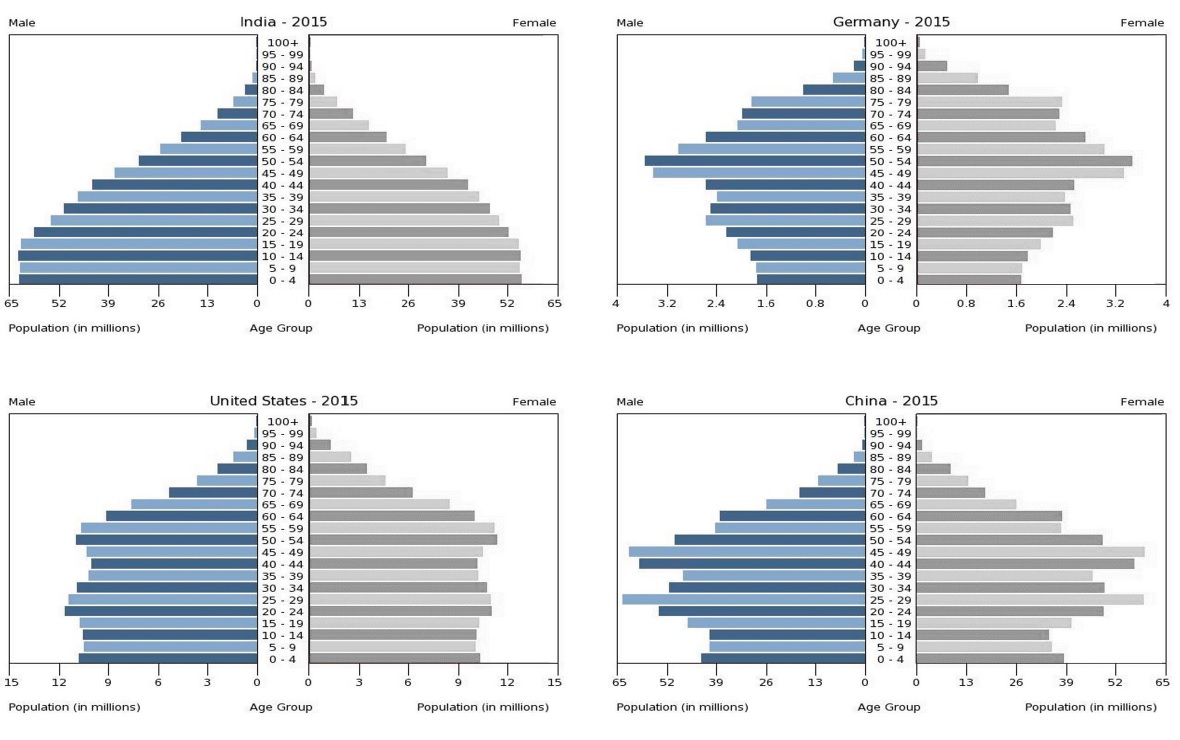 Source: UN Population Statistics
Source: UN Population Statistics
GDP per Capita
India’s GDP per capita is very low compared to the rest of the world, ranked at 160 out of 230. The Oxford School of Economics predicts India’s GDP per capita will increase four-fold from a very low base over the next 20 years. It is very unlikely to see GDP per capita in developed countries experience the same growth. For example, Australia’s GDP per capita would have to increase to around $200,000!
 Source: HSBC Research
Source: HSBC Research
Urbanisation
As Indian’s become wealthier and aspire for more, the country’s level of urbanisation will increase. Like GDP per capita, India’s urbanisation levels are very low compared to the rest of the world. However, as Indians migrate to larger cities this will result in significant spending on consumer goods, infrastructure, power generation, roads, transportation, education and technology.
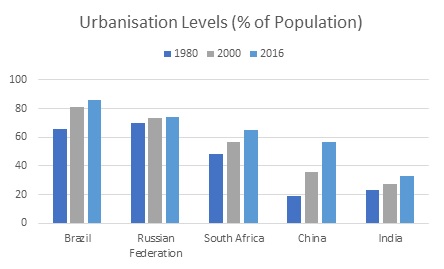
Source: World Bank, India Avenue Research
Government Reforms
Significant reforms are underway to unlock India’s potential, which has often been bogged down by bureaucracy and red tape. The pace of execution has increased significantly under Prime Minister, Narendra Modi. Some of the economic reforms that are seeking to transform India over the next generation are listed below:
- Housing for All - The Government has identified 305 cities and towns in nine states for construction of affordable houses for the poor
- Digital India - Government services are made available to citizens electronically by improved online infrastructure and by increasing Internet connectivity
- Skill India – This program aims to train and equip over 400m people with different skills by 2022. This will create employment opportunities to drive growth and foster increasing wealth for citizens
- Smart Cities – This program’s mission is to develop 100 cities all over the country, making them citizen friendly, connected and sustainable
- Energy Efficiency- A Government-led scheme to improve energy usage, reduce leakage and cut emissions in some of India's most energy-intensive industrial units
- Energy Security – Securing sustainable, affordable and reliable sources of energy
- Swachh Bharat Abhiyan - Clean India Mission aiming to clean up the streets, roads and infrastructure of India's cities, smaller towns, and rural areas
- Make in India – An initiative launched by the Government of India to encourage companies (both local and foreign) to manufacture their products in India
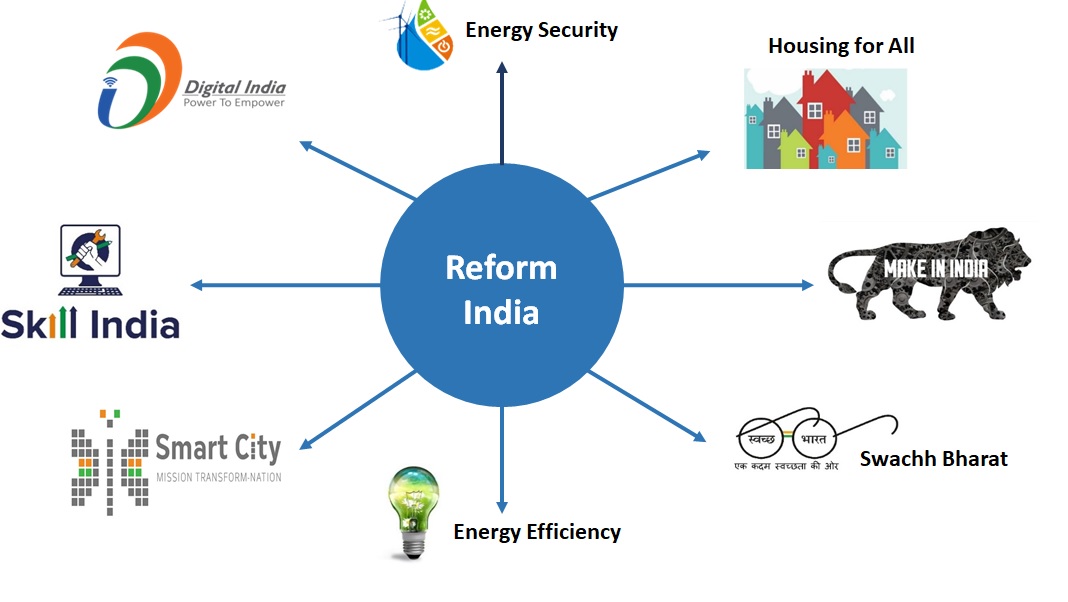 Source: Government of India, India Avenue Research
Source: Government of India, India Avenue Research
Infrastructure Spending
India has a requirement for over US$750bn in infrastructure development by 2022. One critical infrastructure requirement is for road development. Whilst currently the penetration of motor vehicles in India is very low at 18 per 1000 people, this is expected to grow to 110 per 1000 people by 2030, resulting in 140 million more cars on the road. Infrastructure will need to cater to these demands and the Government of India plans to build a road network of 83,677 km over the next five years.
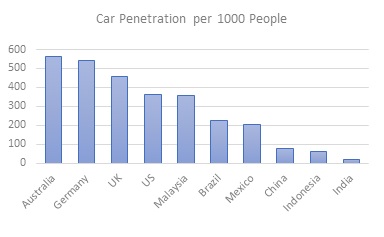
Source: World Bank, India Avenue Research
Consumption Spending
Rising internet penetration is expected to lead to exponential growth in e-commerce. Over the last 10 years, penetration levels have increased nearly 10 times to 30%. This is still very low compared to global standards. Propelled by rising smartphone penetration, the launch of 4G networks and increasing consumer wealth, the Indian e-commerce market is expected to grow to US$200bn by 2026 from US$38.5bn as of 2017.
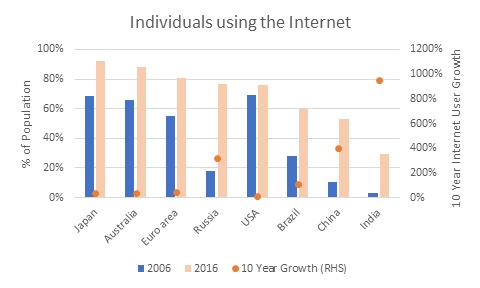
Source: World Bank, India Avenue Research
Equity Market Penetration
Locally based investor’s participation in their equity market is very low but is increasing rapidly over time. The growth has been driven by financial education and systematic investment plans (monthly contributions) as a method of accumulating wealth in financial savings. Strong fund flows are likely to improve liquidity and depth in India’s equity market. Local investments also help reduce the impact of foreign investor’s repatriation of capital, which tend to make markets more volatile.
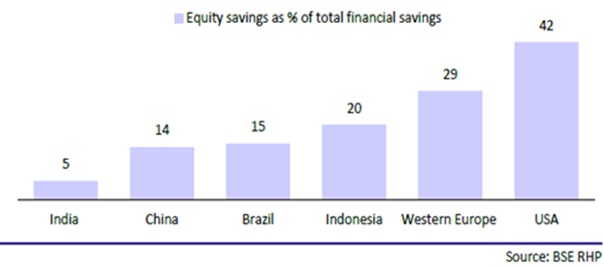
Corporate India’s Earnings Growth
India’s corporate earnings growth has been historically superior to many other markets. We feel this trend will continue going forward due to the following points;
- Strong top line revenue growth – The GDP reflects the size of the opportunity presented to most corporates. This is likely to expand through increasing consumption and expenditure from both the private and public sector
- Stable EPS growth – Indian share markets have a diversified industry profile, dominated by companies predominantly focused on growing their earnings through local consumption demand, rather than offshore sales
- Sustainable capital management – Indian corporates are amongst the highest RoE generators in the world. Their management teams and/or founders have been able to deliver this through ‘sweating’ their assets and managing costs, creating more efficiently utilised shareholder capital

Equity Market Returns
Whilst identification of themes and long-term trends is half the battle, for equity investors this must result in capital gains. India’s equity markets have significantly rewarded investors over the long term.
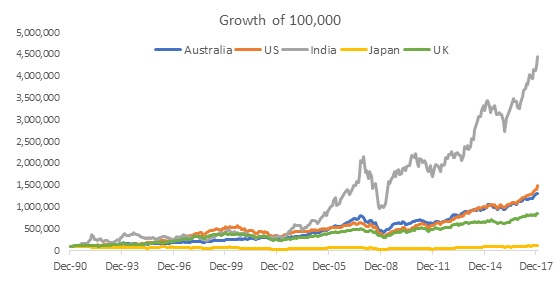
Source: Bloomberg, India Avenue Research
The above graph is purely from an index perspective. Good stock selection in India can be significantly more rewarding given the large dispersion between strongly performing companies and the rest of the market. This dispersion is in fact higher in more inefficient markets like India. The chart below shows a significant portion of Indian companies (nearly 50%) were able to deliver 20% p.a. returns over the last 20 years!
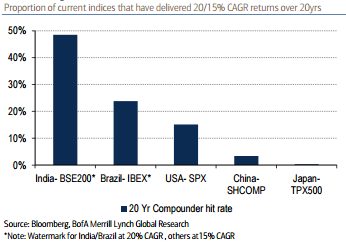
7 topics

